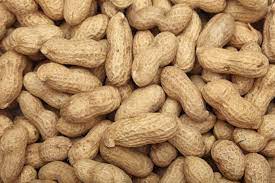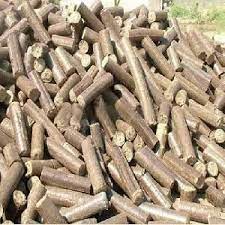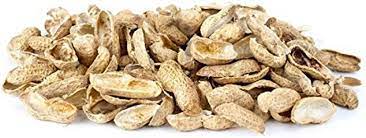Groundnuts/Peanuts Shells, also commonly known as peanuts, are a type of legume that grows underground. The shell of a groundnut or peanut is the protective outer covering that encases the edible seed inside. The shell is an important part of the peanut’s structure, serving to protect the seed from damage, pests, and environmental factors.
Groundnut shells are small, usually around 1 to 2 inches (2.5 to 5 centimeters) in length. They are oval-shaped, resembling elongated ellipsoids.
The shell’s texture is somewhat rough and granulated, consisting of small bumps or ridges. The surface of the shell may not be entirely uniform, and there can be slight variations in texture.
The color of peanut shells can range from light tan to a reddish-brown hue. The exact shade may vary depending on the peanut variety and how it was processed.
Groundnut shells are primarily composed of cellulose, lignin, and other natural fibers. They are relatively rigid and provide excellent protection to the seeds within.
When consuming peanuts as a snack or in cooking, the shells are typically removed to access the edible part. Peanuts are often shelled before being roasted, boiled, or used in various dishes.
Peanut shells are sometimes used for other purposes after the peanuts have been removed. They can be utilized as animal feed, in composting, or as a mulch to improve soil conditions.
Peanut shells are biodegradable, which means they can break down naturally over time, contributing to organic matter in the soil.
It is essential to note that some individuals may be allergic to peanuts. In such cases, contact with the shells or the peanut dust can trigger allergic reactions.
Peanut shells play a crucial role in protecting the seeds during growth and transportation. While they are not consumed directly by humans, they can have various uses after the peanuts have been removed, making them a valuable and sustainable part of the peanut’s life cycle
Economic Importance, Uses, and By-Products of Groundnuts/Peanuts Shells

Groundnut shells, also known as peanut shells, have several economic importance and uses beyond just being a byproduct of the peanut industry. Here are some of them:
1. Animal Feed: Groundnut shells can be used as a component of animal feed, particularly for ruminants like cattle and goats. While they are not as nutritious as the groundnut itself, they still contain some protein, fiber, and other nutrients that can be beneficial to livestock. Farmers may mix groundnut shells with other feed ingredients to create balanced and cost-effective animal diets.
2. Fuel: Groundnut shells have been used as a source of fuel in some regions. They can be burned to generate heat and energy, particularly in areas where other sources of fuel are scarce or expensive. However, this use of groundnut shells for fuel is becoming less common due to concerns about environmental impacts and competition with other uses.
3. Fertilizer and Soil Amendment: Groundnut shells can be composted and used as organic fertilizer or soil amendment. When properly composted, they can enhance soil structure, improve water retention, and provide nutrients to plants. Groundnut shells add organic matter to the soil, promoting microbial activity and overall soil health.
4. Biomass and Bioenergy: Groundnut shells are a type of biomass, which means they can be used as a renewable energy source. Through advanced technologies, groundnut shells can be converted into bioenergy, such as biofuels or biogas, which can be used to generate electricity or as an alternative to fossil fuels.

5. Industrial Absorbent: The high absorbent capacity of groundnut shells makes them suitable for industrial applications, such as spill cleanup and oil absorption. They can be used to absorb oils, chemicals, and other substances, making them an eco-friendly and cost-effective alternative to synthetic absorbents.
6. Building Materials: In some regions, groundnut shells are incorporated into building materials. For instance, they can be used as an additive in clay bricks to improve their insulating properties and reduce the overall weight of the bricks.
7. Mushroom Cultivation: Groundnut shells have been used as a substrate for cultivating certain types of mushrooms, such as oyster mushrooms. They provide a suitable environment for mushroom growth and can be a low-cost alternative to other substrates.
8. Handicrafts and Decorations: In some cultures, groundnut shells are creatively used in handicrafts and decorations. They can be dyed, painted, or arranged to make various decorative items like jewelry, baskets, and artwork.
9. Bedding Material: Groundnut shells can serve as bedding material for animals, such as poultry and small pets like rabbits and guinea pigs. The shells provide a comfortable and insulating surface for the animals to rest on. Additionally, the absorbent properties of the shells help to keep the bedding relatively dry, contributing to the health and well-being of the animals.
Read Also : Economic Importance, Uses, and By-Products of Groundnuts/Peanuts Taproots
10. Erosion Control and Land Reclamation: In some areas, groundnut shells have been used for erosion control and land reclamation projects. The shells can be spread over slopes to reduce soil erosion caused by water runoff. When decomposed, they add organic matter to the soil, helping to improve its fertility and structure for vegetation growth.
11. Charcoal Production: In some traditional charcoal-making processes, groundnut shells have been utilized as a raw material. The shells are carbonized in a controlled environment, resulting in charcoal, which can be used as a fuel source or for other purposes.
12. Horticulture and Gardening: Groundnut shells can be employed in horticulture and gardening as a mulch material. By spreading a layer of groundnut shells on the soil surface around plants, gardeners can help retain soil moisture, suppress weed growth, and regulate soil temperature. As the shells break down, they contribute organic matter to the soil.
13. Insulation Material: Innovatively, groundnut shells have been used to create insulation materials for various purposes, including thermal and sound insulation. The shells’ natural fibrous and insulating properties make them suitable for such applications.
14. Filtration and Water Purification: Groundnut shells can be used as a filtration medium for water treatment. Due to their porous structure, they can effectively remove certain contaminants and impurities from water, acting as a low-cost and sustainable filtering material.
15. Packaging Material: Groundnut shells, when processed into a suitable form, can be used to create biodegradable and eco-friendly packaging materials. These materials can be utilized as cushioning agents for fragile products or as fillers in packaging boxes, reducing the need for non-biodegradable alternatives.
16. Biochar Production: Biochar is a type of charcoal produced from organic materials like groundnut shells through a process called pyrolysis. Biochar has various agricultural benefits, such as improving soil fertility, increasing water retention, and sequestering carbon. It can be used as a soil amendment to enhance crop productivity and contribute to sustainable agriculture.
17. Vermicomposting: Groundnut shells can be used in vermicomposting, a process where earthworms are utilized to decompose organic waste. When groundnut shells are composted with the help of earthworms, they break down into nutrient-rich vermicompost, which is a valuable organic fertilizer for plants.
18. Art and Craft Supplies: Artists and crafters may find groundnut shells useful for creating unique art pieces and craft projects. They can be used as natural texturing agents, collage materials, or even as part of sculptures and mixed media artwork.
19. Insulation in Animal Shelters: In animal shelters and barns, groundnut shells can be used as insulation materials. They can help regulate temperature and create a more comfortable environment for the animals.
20. Cosmetics and Personal Care: Groundnut shells have been explored for potential uses in cosmetics and personal care products. Groundnut shell powder can act as a gentle exfoliant in skincare products, providing a natural and biodegradable alternative to microbeads.
21. Seedling Trays: Groundnut shells can be compressed or molded into biodegradable seedling trays for nursery and horticulture purposes. These trays can be directly planted into the soil, reducing transplant shock and minimizing waste.
22. Organic Pest Control: In some cases, groundnut shells have been used as a natural pest deterrent. When spread around plants or crops, the sharp edges of the shells can discourage pests from damaging the vegetation.
23. Production of Particle Boards: Groundnut shells can be processed to create particle boards, which are engineered wood products used in construction and furniture manufacturing. These boards provide a sustainable alternative to traditional wood-based products.
It is essential to note that while groundnut shells have numerous potential uses, their commercial viability may vary depending on factors such as regional demand, processing costs, and environmental considerations. Additionally, when utilizing groundnut shells for industrial or commercial purposes, it is crucial to ensure that their production does not negatively impact food security or the livelihoods of local communities who rely on groundnut crops for sustenance and income.
Overall, the versatile uses of groundnut shells present opportunities for economic gain, waste reduction, and sustainable practices in various industries and applications.
The Products and By-products That Can Be Derived From Groundnuts/Peanuts Shells

Groundnut shells, also known as peanut shells, are the outer coverings of peanuts and can be utilized in various ways to produce several products and by-products. Here are some examples and explanations of the products that can be derived from groundnut shells:
1. Animal Feed: Groundnut shells can be processed and used as animal feed due to their high fiber content. They are particularly useful as feed for ruminant animals like cattle and goats.
2. Biochar: Groundnut shells can be converted into biochar through a process called pyrolysis, which involves heating the shells in the absence of oxygen. Biochar is a valuable soil amendment that helps improve soil fertility and carbon sequestration.
3. Briquettes: Groundnut shells can be compressed into briquettes, which are a type of fuel. These briquettes can be used for cooking and heating purposes, providing an eco-friendly alternative to traditional charcoal or firewood.
Read Also : Economic Importance, Uses, and By-Products of Groundnuts/Peanuts Stems
4. Mulch: Groundnut shells can be shredded and used as mulch for gardening and agriculture. Mulching helps retain soil moisture, control weeds, and improve soil structure.
5. Activated Carbon: Groundnut shells can be converted into activated carbon, which is widely used in water purification, air filtration, and various industrial processes.
6. Biomass Pellets: Groundnut shells can be processed into biomass pellets, which are used as a renewable energy source. These pellets can be burned to generate heat and electricity.
7. Cattle Bedding: Groundnut shells can be used as bedding material for cattle and other livestock, providing a comfortable and absorbent surface.
8. Paper Production: Groundnut shells can be used as a raw material for paper production, contributing to the production of eco-friendly paper products.
9. Mushroom Cultivation: Groundnut shells can be mixed with other organic materials to create a substrate for growing mushrooms. They provide a suitable base for mushroom mycelium to colonize and produce mushrooms.
10. Organic Fertilizer: Groundnut shells can be composted and used as organic fertilizer. The composted shells enrich the soil with nutrients and improve its structure.
11. Particle Board: Groundnut shells can be used to manufacture particle boards. These boards are made by compressing the groundnut shell particles with adhesive under heat and pressure. Particle boards find applications in furniture and construction industries.
12. Insulation Material: The fibrous nature of groundnut shells makes them suitable for producing insulation materials. The shells can be processed and used to create thermal or sound insulation products.
13. Oil Extraction: Groundnut shells contain some oil, which can be extracted using solvent extraction methods. The extracted oil can find application in various industries, such as cosmetics and lubricants.
14. Activated Carbon Filters: Groundnut shells can be processed into activated carbon filters used in air and water purification systems to remove contaminants and impurities.
15. Crafts and Artwork: Groundnut shells can be creatively used in arts and crafts. They can be painted, glued, or assembled to make various decorative items or even small sculptures.
16. Oil Extraction: The process of extracting oil from groundnut shells involves crushing the shells to create a fine powder and then using a solvent like hexane to extract the oil. The solvent is later evaporated, leaving behind the extracted oil.
It’s important to mention that the utilization of groundnut shells for various products and by-products is not only economically beneficial but also environmentally friendly. Recycling and reusing agricultural waste like groundnut shells can help reduce the burden on landfills and promote sustainable practices. Additionally, groundnut shells’ widespread utilization contributes to a circular economy where waste materials are converted into valuable resources. However, the feasibility of these processes and products may vary depending on factors such as scale of production, market demand, and available technology.
Read Also : Benefits of Practicing Commercial Farming
